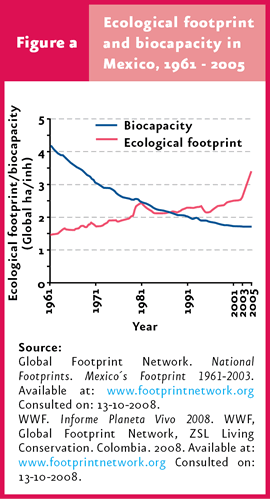The improper use of natural resources currently taking place worldwide has led to a steady increase in the countries’ ecological footprint at the expense of their biocapacity. Mexico is no exception. In 1961, its biocapacity was 4.1 global hectares, with an ecological footprint of 1.4 global hectares per person (Figure a). By 2005, its biocapacity dropped to 1.7 global hectares per person and the ecological footprint increased to 3.4. This means that each person living in Mexico had an ecological footprint deficit of 1.7 global hectares; that is, on average, each Mexican uses a larger area of land to meet his/her needs for food and products and to dispose of his/her wastes than the area available to support him/her in a sustainable manner in the country.

Of all the components that make up the ecological footprint, the surface area required for the absorption of CO2 produced by fossil-fuel burning is the one displaying the highest increase. In 1961 this area was 0.07 global hectares per person, while in 2005 it had increased to 1.92 global hectares per person (Figure b). To date, the ecological footprint of the large Mexican cities has not been calculated, but it is expected to be high. One of the cities for which this information is available is Xalapa, in the state of Veracruz, with an ecological footprint calculated at 2.9 global hectares per person. Another example is Jalisco, where the average ecological footprint for the urban zones of three municipalities (Cabo Corrientes, Tomatlan and Puerto Vallarta) was calculated at 2.75, with an ecological deficit of 0.80 global hectares per person; in rural areas the ecological footprint was 2.38 and the ecological deficit was 0.38. For domestic tourists who visit Puerto Vallarta the ecological footprint was 4.36, with an ecological deficit of 3.56. For foreign tourists, the ecological footprint was 11.29 and the ecological deficit was 9.49 global hectares per person.

References:
Chávez-Dagostino, R.S., J.L. Cifuentes-Lemus, E., Andrade-Romo, R. Espinoza-Sánchez, B.H. Massam & J. Everitt. Huellas ecológicas y sustentabilidad en la costa norte de Jalisco, México. Teoría y Praxis 5:147–144. 2008. Available at: www.teoriaypraxis.uqroo.mx/doctos/Numero5/Chavez-Andrade.pdf [Consulted on: October 1, 2008].
Global Footprint Network. Mexico’s Footprint 1961-2003. 2006. Available at: www.footprintnetwork.org/webgraph/graphpage.php?country=mexico [Consulted on: October 1, 2008].
Nieto Caraveo, L.M. La huella ecológica. ¿Qué tantos recursos naturales tenemos? ¿Qué tantos recursos naturales usamos? 1999. Available at: http://ambiental.uaslp.mx/docs/LMNC-AP990325.pdf [Consulted on: October 1, 2008].
WWF. Informe Planeta Vivo 2008. Global Footprint Network, ZSL-Living Conservation. Colombia. 2008.
|